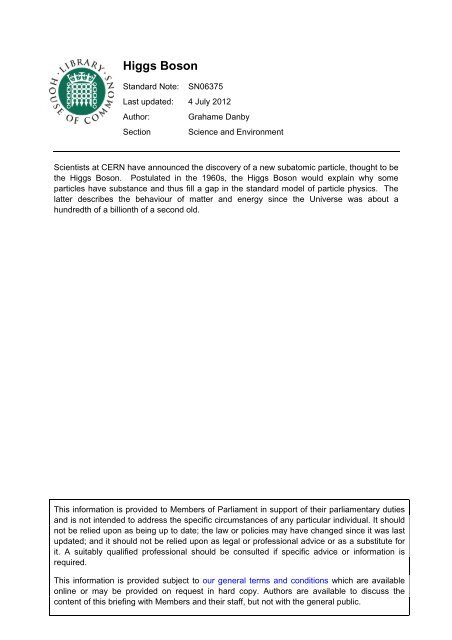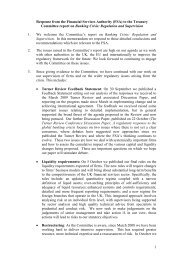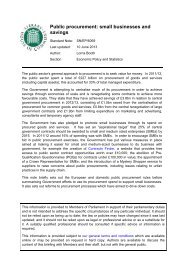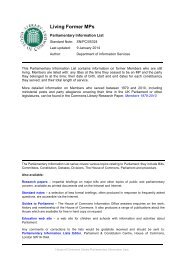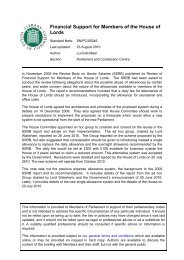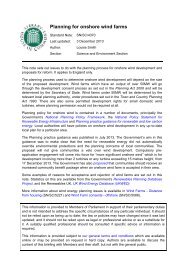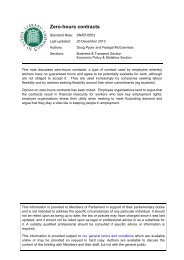Higgs Boson ( PDF, 3 pages, 48.51 KB) - Parliament
Higgs Boson ( PDF, 3 pages, 48.51 KB) - Parliament
Higgs Boson ( PDF, 3 pages, 48.51 KB) - Parliament
You also want an ePaper? Increase the reach of your titles
YUMPU automatically turns print PDFs into web optimized ePapers that Google loves.
<strong>Higgs</strong> <strong>Boson</strong><br />
Standard Note: SN06375<br />
Last updated: 4 July 2012<br />
Author: Grahame Danby<br />
Section Science and Environment<br />
Scientists at CERN have announced the discovery of a new subatomic particle, thought to be<br />
the <strong>Higgs</strong> <strong>Boson</strong>. Postulated in the 1960s, the <strong>Higgs</strong> <strong>Boson</strong> would explain why some<br />
particles have substance and thus fill a gap in the standard model of particle physics. The<br />
latter describes the behaviour of matter and energy since the Universe was about a<br />
hundredth of a billionth of a second old.<br />
This information is provided to Members of <strong>Parliament</strong> in support of their parliamentary duties<br />
and is not intended to address the specific circumstances of any particular individual. It should<br />
not be relied upon as being up to date; the law or policies may have changed since it was last<br />
updated; and it should not be relied upon as legal or professional advice or as a substitute for<br />
it. A suitably qualified professional should be consulted if specific advice or information is<br />
required.<br />
This information is provided subject to our general terms and conditions which are available<br />
online or may be provided on request in hard copy. Authors are available to discuss the<br />
content of this briefing with Members and their staff, but not with the general public.
Contents<br />
1 <strong>Higgs</strong> <strong>Boson</strong> 2<br />
2 Further reading 3<br />
1 <strong>Higgs</strong> <strong>Boson</strong><br />
On 4 July 2012, the discovery of a subatomic particle thought to be the long sought <strong>Higgs</strong><br />
<strong>Boson</strong> was announced by scientists at CERN (European Organization for Nuclear<br />
Research).<br />
The existence of the <strong>Higgs</strong> <strong>Boson</strong> was proposed by a number of scientists, including the<br />
British physicist Peter <strong>Higgs</strong>, to explain why some elementary particles have mass (mass is a<br />
property that manifests itself as weight in the presence of gravity). If the <strong>Higgs</strong> <strong>Boson</strong> has<br />
indeed been found then it would be the last elementary particle needed to “complete the set”<br />
that makes up the standard model of particle physics. Elementary particles (quarks, leptons<br />
and some bosons) make up matter and account for its properties. The standard model<br />
doesn’t explain the origin of gravity though.<br />
The <strong>Higgs</strong> <strong>Boson</strong> is thought to have originated when the Universe was about 10 -11 (“ten to<br />
the minus 11” or 0.000 000 000 01) seconds old. While much of interest undoubtedly<br />
occurred in the first hundredth of a billionth of a second of the Universe’s history, the<br />
discovery of the <strong>Higgs</strong> <strong>Boson</strong> would place on a more secure footing the standard model of<br />
particle physics that, at least in principle, explains how matter and energy have behaved ever<br />
since. That is not to deny that relatively recent isolated developments like the emergence of<br />
life are more appropriately described using other scientific models! While its importance<br />
should not be underestimated, the popular description of the <strong>Higgs</strong> <strong>Boson</strong> as the “God<br />
particle” is clearly hype.<br />
The Large Hadron Collider at CERN works by accelerating and colliding subatomic particles<br />
called protons. The energy produced in such collisions is partly converted into material<br />
subatomic particles, a consequence of the equivalence of matter and energy embodied in<br />
Einstein’s famous equation E = mc 2 (this really just equates energy and mass; the c-squared<br />
can be thought of as a conversion factor).<br />
The Institute of Physics explains how the search for the <strong>Higgs</strong> <strong>Boson</strong> has been taking place:<br />
It's thought that the mass of the <strong>Higgs</strong> – which isn't predicted by theory and has to be<br />
determined by experiment – is very high, so the particle would take a huge amount of<br />
energy to produce. This is just one of the main aims of the Large Hadron Collider at<br />
CERN, the most powerful particle accelerator yet built.<br />
[...]<br />
CERN's announcement of December 2011 hints of the <strong>Higgs</strong> at around 124–126 GeV<br />
[gigaelectronvolts]. However the signal at this mass level was at best 2.6 standard<br />
deviations above the mean of the background fluctuations, whereas a discovery is only<br />
2
considered to have been made when it reaches five standard deviations – the muchhyped<br />
“five sigma” level. 1<br />
A couple of points on the last paragraph:<br />
1. The gigalectronvolt (a billion electronvolts) is a unit of energy often used to describe<br />
the mass of subatomic particles. This is fine because mass and energy are<br />
equivalent.<br />
2. The term “five sigma” comes from statistics and means five standard deviations. The<br />
Guardian explains its significance:<br />
When they calculate whether a particular bump in the data is significant, particle<br />
physicists use a five-point "sigma" scale. One sigma means that the results are not too<br />
far from being random statistical fluctuations in the data. A three-sigma result counts<br />
as an observation, but only a full, five-sigma result means that scientists can count it as<br />
an official discovery. This means that there is less than a one-in-a-million chance of the<br />
result being a statistical fluke. 2<br />
2 Further reading<br />
The Large Hadron Collider, CERN<br />
CERN experiments observe particle consistent with long-sought <strong>Higgs</strong> boson, CERN, 4 July<br />
2012<br />
<strong>Higgs</strong> boson-like particle discovery claimed at LHC, BBC, 4 July 2012<br />
Q&A: The <strong>Higgs</strong> boson, BBC, 4 July 2012<br />
1<br />
2<br />
http://www.iop.org/resources/topic/archive/higgs/index.html<br />
http://www.guardian.co.uk/science/2012/jun/29/higgs-boson-rumours-fly-cern-results<br />
3


